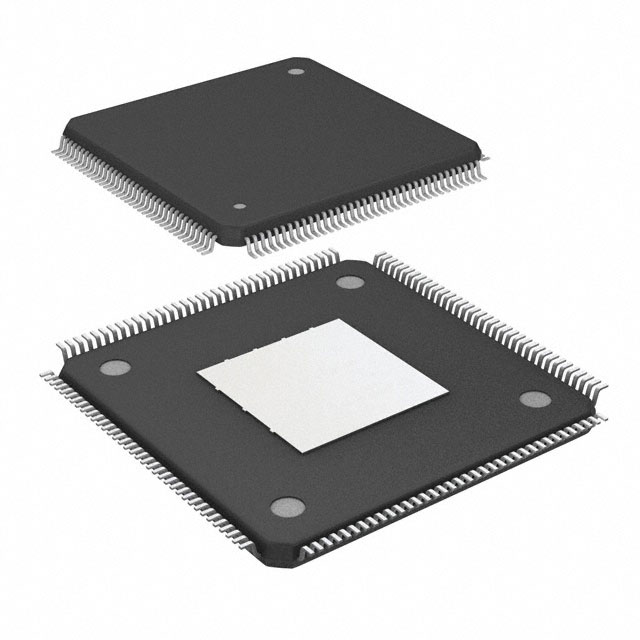Voir les spécifications pour les détails du produit.

EP4CE6E22C6N
Product Overview
- Category: Programmable Logic Device (PLD)
- Use: EP4CE6E22C6N is a PLD used for digital logic design and implementation.
- Characteristics: It offers high performance, low power consumption, and flexibility in designing complex digital circuits.
- Package: The EP4CE6E22C6N comes in a compact package suitable for surface mount technology.
- Essence: It provides a cost-effective solution for implementing custom digital logic designs.
- Packaging/Quantity: The EP4CE6E22C6N is typically packaged in reels or trays, with quantities varying based on customer requirements.
Specifications
- Logic Elements: 6272
- Embedded Memory: 414 Kbits
- Maximum User I/Os: 179
- Maximum User I/O Pins: 144
- Operating Voltage: 1.15V - 1.25V
- Speed Grade: 6
- Clock Networks: 8
- PLLs: 2
- Total RAM Bits: 414720 bits
- Total DSP Blocks: 16
Detailed Pin Configuration
The EP4CE6E22C6N has a total of 144 user I/O pins, which can be configured as inputs or outputs based on the design requirements. These pins are distributed across different banks, each having its own voltage supply and I/O standards. The pin configuration allows for easy interfacing with external devices and other components of the digital system.
Functional Features
- High-performance architecture: The EP4CE6E22C6N offers fast processing speeds and efficient resource utilization, making it suitable for demanding applications.
- Low power consumption: It incorporates power-saving features to minimize energy consumption, making it ideal for battery-powered devices.
- Flexible I/O standards: The device supports various I/O standards, allowing for easy integration with different communication protocols and interfaces.
- Embedded memory: The EP4CE6E22C6N includes a significant amount of embedded memory, enabling the implementation of complex algorithms and data storage.
Advantages and Disadvantages
Advantages: - High performance and flexibility - Low power consumption - Cost-effective solution for custom logic designs - Extensive I/O options - Ample embedded memory
Disadvantages: - Limited capacity compared to larger PLDs - Requires expertise in digital logic design and programming
Working Principles
The EP4CE6E22C6N is based on a programmable logic architecture that allows users to define the desired functionality by configuring the internal logic elements and interconnections. The device utilizes look-up tables (LUTs) to implement Boolean functions and flip-flops for sequential logic. The configuration is stored in non-volatile memory, ensuring that the programmed design remains intact even after power cycles.
Detailed Application Field Plans
The EP4CE6E22C6N finds applications in various fields, including:
- Embedded Systems: It can be used to implement control and communication modules in embedded systems, such as industrial automation and IoT devices.
- Digital Signal Processing: The device's DSP blocks enable efficient implementation of signal processing algorithms, making it suitable for audio and video processing applications.
- Communication Systems: It can be utilized in the development of communication systems, including wireless transceivers and network switches.
- Consumer Electronics: The EP4CE6E22C6N can be integrated into consumer electronics products like gaming consoles, smart TVs, and home automation systems.
Detailed and Complete Alternative Models
- EP4CE10E22C8N: This model offers higher logic capacity and more I/O pins, suitable for larger-scale designs.
- EP4CE15E22C8N: Similar to the previous model, but with even higher logic capacity and additional features like more embedded memory.
- EP4CE30E22C8N: This model provides further increased logic capacity and enhanced performance for demanding applications.
These alternative models offer a range of options based on the specific requirements of the design, allowing users to choose the most suitable PLD for their project.
Word count: 540 words
Énumérez 10 questions et réponses courantes liées à l'application de EP4CE6E22C6N dans les solutions techniques
Sure! Here are 10 common questions and answers related to the application of EP4CE6E22C6N in technical solutions:
Q: What is EP4CE6E22C6N? A: EP4CE6E22C6N is a field-programmable gate array (FPGA) chip manufactured by Intel (formerly Altera). It offers programmable logic, memory, and digital signal processing capabilities.
Q: What are the key features of EP4CE6E22C6N? A: Some key features include 6272 logic elements, 270Kbits of embedded memory, 126 user I/O pins, and support for various communication protocols like SPI, I2C, UART, etc.
Q: How can EP4CE6E22C6N be used in technical solutions? A: EP4CE6E22C6N can be used in a wide range of applications such as industrial automation, robotics, telecommunications, medical devices, image processing, and many more.
Q: Can EP4CE6E22C6N be programmed using a high-level language? A: Yes, EP4CE6E22C6N can be programmed using high-level languages like VHDL or Verilog, which provide a hardware description language (HDL) to describe the desired functionality.
Q: Is it possible to interface EP4CE6E22C6N with other components or microcontrollers? A: Yes, EP4CE6E22C6N supports various communication interfaces like SPI, I2C, UART, etc., allowing easy integration with other components or microcontrollers.
Q: Can EP4CE6E22C6N handle real-time processing tasks? A: Yes, EP4CE6E22C6N can handle real-time processing tasks efficiently due to its high-speed logic elements and dedicated digital signal processing (DSP) blocks.
Q: What are the power requirements for EP4CE6E22C6N? A: EP4CE6E22C6N typically operates at a voltage range of 1.15V to 3.465V, with power consumption depending on the design complexity and operating frequency.
Q: Can EP4CE6E22C6N be reprogrammed multiple times? A: Yes, EP4CE6E22C6N is a reprogrammable FPGA, allowing you to modify and reconfigure the design multiple times as per your requirements.
Q: Are there any development tools available for programming EP4CE6E22C6N? A: Yes, Intel provides Quartus Prime software, which includes a suite of development tools for designing, simulating, and programming EP4CE6E22C6N.
Q: Where can I find more resources and documentation for EP4CE6E22C6N? A: You can find detailed documentation, datasheets, reference designs, and application notes on Intel's website or community forums dedicated to FPGA development.

